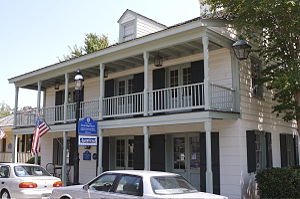Tivoli High House
| Tivoli High House | |
 | |
| Building Information | |
|---|---|
| Location | 205 East Zaragoza Street |
| Architect | Theophalis May (reproduction) |
| Current Owner | West Florida Historic Preservation |
| Completion Date | 1805 (original) 1979 (reproduction) |
| Date Demolished | 1937 |
The Tivoli High House is a building located at 205 East Zaragoza Street. It was built in 1979 as a reproduction of the original building, which was built in 1805 on the same site and demolished in 1937. The name derives from the Calle de Tivoli, an early name for Zaragoza Street.
The building is owned by West Florida Historic Preservation and a part of Historic Pensacola Village, which holds its ticket office on the first floor. The second floor of the building houses the offices of the Pensacola Symphony Orchestra.
History[edit]
The original Tivoli High House was part of a complex built in 1805 by Jean Baptiste Cazenave, Pedro Bardinave and Rene Chardiveneau. The complex also included the Tivoli Dance Hall, an octagonal rotunda with a 20-foot radius to the east of the main building, as well as a kitchen and other outbuildings. It was a one-and-a-half story structure built on a foundation of tall brick piers, which may have been necessitated by a much closer waterfront. As the shoreline receded over the years, the bottom floor was enclosed with plaster and stone façade.
The buildings were likely used for billiards and gaming, and an 1810 description mentions "a small neat rotunda for public balls." The complex was purchased in the 1840s by Don Francisco Moreno, demolishing the ballroom to construct a private residence, and converting the High House into the Hotel de Paree. The building was used by Union soldiers during the Civil War, during which it was known as the "Spanish Barracks." It remained a boarding house under various names and owners until its demolition in 1937.
Through a cooperative effort by state and local governments, the Florida American Bicentennial Commission and the American Revolution Administration, the building was reconstructed in 1976. Local architect Theophalis May designed the plans from historic photographs.